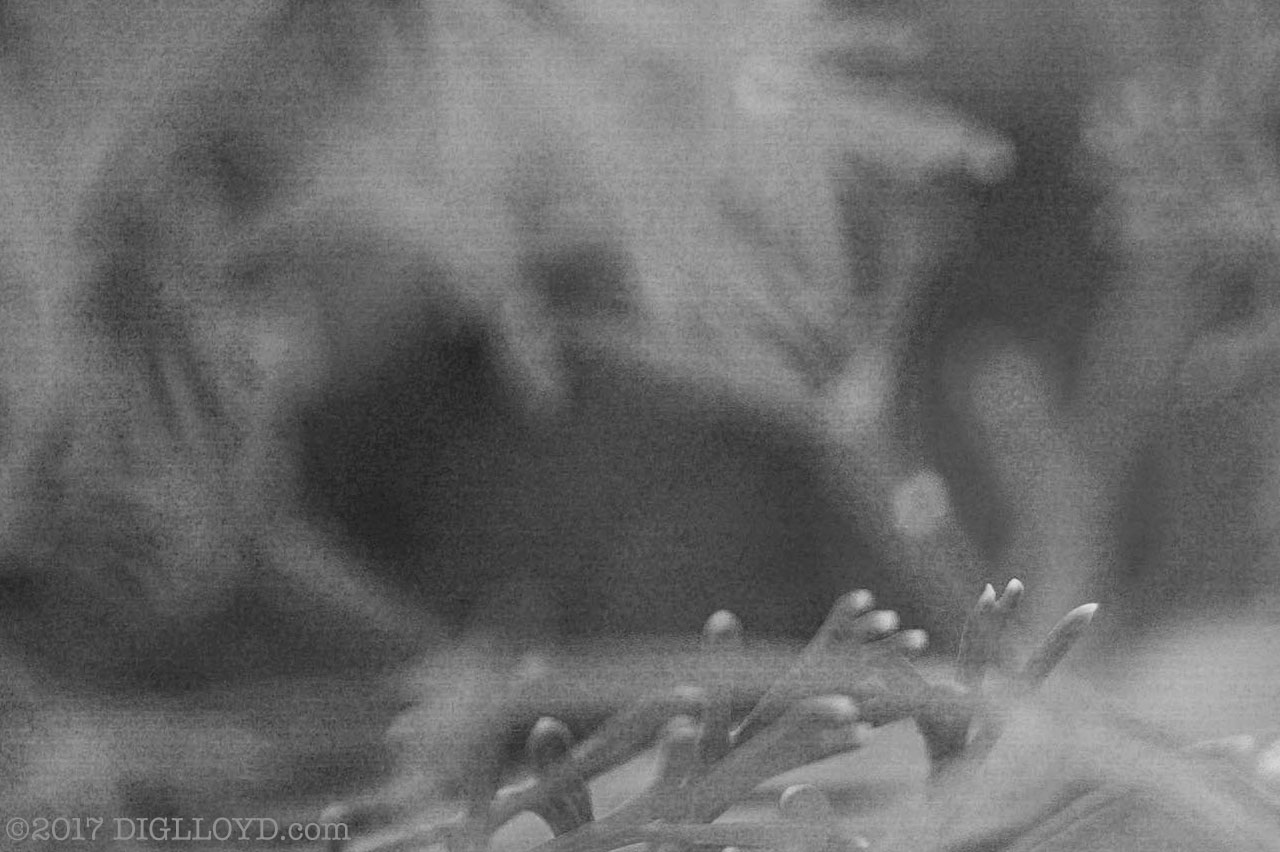Sony A9: Pattern/Banding Noise at ISO 100 (plus reader comments)
Get the about $4499 Sony a9 and about $2499 Sony FE 100-400mm f/4.5-5.6 GM OSS at B&H Photo.
Update: see the followup studies.
...
Obvious noise at ISO 100 on a 24 megapixel sensor is unexpected and very disappointing, but that’s exactly what I found with the Sony A9 without even having to go looking—one of the first few one-off shots I made.
I noticed some unexpected streaking in an image with a good exposure at ISO 100. The red channel is overlaid with horizontal lines/streaks in 12-pixel-high bands. Pattern noise is disturbing in any case, but to have it at ISO 100 with a good exposure is a huge negative for any camera, high speed shooter or not.
Sony A9: Pattern/Banding Noise at ISO 100
Includes images up to full resolution including the red channel from the ProPhotoRGB and sRGB color images, RawDigger histogram and Adobe Camera Raw conversion settings.
I’ve not seen noise this egregiously bad for years now. I find it unacceptable except perhaps at some super-bonkers high ISO, but this is ISO 100. Possible diagnosis: the high-speed readout of the A9 sensor does not read out groups of rows evenly; there is some difference in gain between the rows. The pattern noise repeats in row groups that are 12 pixels high.

The image below is in color and greatly reduced in size, so the red-channel noise will not be visible here.

Sony A9 + Zeiss Batis 135mm f/2.8
[low-res image for bot]
Roy P writes:
Looks ugly. It might not be a factor for a lot of images, but it could be a bad problem for some. Any chance it could be fixed with a firmware upgrade, or do you think it’s a hardware problem? When this happens, could applying some NR mitigate it, without affecting overall sharpness?
DIGLLOYD: I think it relates directly to the high-speed readout of the sensor: the regular spacing seems directly related to the high-speed readout (groups of 12 rows being read out in this case at 1/800, though the group size might very with shutter speed). It seems doubtful to me that there would be a workaround given the core design is aimed at very high frame rate capture.
Mark H writes:
I am finding some commentary on the Sony A9 a little bit silly, especially in relation to the work you do.
I pre-ordered an A9 at 10:01 AM the day B&H offered it for sale (through your link). I did NOT do so because I thought it would give better image quality than any previous A series camera (it will not). I bought it because $4500 is a small price to pay for penalty free, 100% silent, black out free, THEATER photography. Finally, no muzzle, sweaty blanket over the head, angry glares, or insecurity about possibly disturbing other patrons in a dark quiet theater. This is the camera of my dreams for DISCRETION. And that really, really matters for many subjects. Now I can photograph performances, completely invisible, rather than being limited to dress rehearsals because of unacceptable mirror slap or shutter noise. Or more recently, struggle with the sluggishness of an A7sii with its black out just for its silent e-shutter capability. I’ve gone from D3s, to Df, to A7sii and now to A9.
However, this camera is not currently relevant to your site or your work any more than a Nikon D3s is. The value in your work, even to people like me who do not invest in mega pixels or 12 vs 14 bit this or that, is to know where sensor technology is now and is going. I do care to know what the outer limit is, and I find it interesting to know where the A9 fits in that. But I would not be offended if you never even reviewed it. I read your work to be informed of the ultimate attainable image quality, even if I have no intention to hike that system into a mountain range and use it.
I bought an A9 not knowing or caring if the quality at 200% on a 5K screen would be as good as the a7sii. On paper, I already knew it would help me photograph dancers and be invisible. Anyone reading your articles to make a decision about the Sony A9 is missing both the point of this camera and your work as a resource. I suspect the most confused commenters may not even be subscribers. Spending too much time on this camera would be like refreshing your review of the D3x after the D820 is released.
Please keep informing us about the highest IQ available in digital imaging, and feel free to leave these “single purpose, one step backward” cameras to others to argue about.
Thank you again for your great work.
DIGLLOYD: I suspect that the noise will be less of an issue than it seems for things like theatre work (overlit subjects, shadowed backgrounds). Also, using higher ISO adds noise of its own that might mask the pattern noise. In any case, high contrast outdoor and indoor/outdoor work makes similar demands in terms of dynamic range, and so I think a bit of non-theatre outdoor work or something like this with the Leica SL is a reasonable proxy for theater work.
The bottom line for me is as Mark H alludes to: the Sony A9 is not my cup of tea, but on the other hand I need to be aware of the range of sensor performance as it provides valuable context to my work over time. Accordingly, the A9 is not a camera I want to completely ignore. I will take it as far as it goes in terms of understanding the technology, since we might see Sony go down this path even on a high-res camera (A7R III or whatever it might be)—but while I like blackout-free operation, I want any high-res camera to make image quality the #1 priority. So I could give up blackout-free and 5 fps would be just fine if that were required for the best image quality.
JH writes:
I have ordered my Sony a9 and it's coming to my home, after reading your article about the problem of pattern/banding on ISO 100, I have to decide whether should I return to the online store because the reason I bought it is to taking pictures of my kids and both a6500 and A7R2 cannot grab the focus when the kids are moving fast. I also browsed quite a few web sites and got a handful RAW files or big jpeg files, but I didn't observe the pattern/banding noise you've found. Would you mind to check again with other lens than Batis 135 and under different environments to rule out the possibility that your A9 is a bad sample or confirm it is general for all a9 bodies?
... Thanks for your reply. I am still worried about the patterned noise which will be quite annoying if printed on paper, especially transformed to B&W. Could you say a bit more about in what circumstances the noise could be reproduced?
DIGLLOYD: my advice is to stay on plan. The A9 has unique features that are worthy. I don’t expect the pattern noise to manifest in all circumstances or in JPEGs, which compress-out both detail and noise to some extent.
The “bad sample” idea is a hope that I hear every time I find a camera performance issue. It has never been more than false hope. It would make no sense, particularly since the pattern is clearly related to the way the electronic shutter operates (groups of rows).
I’ll be looking to reproduce the issue under circumstances of various kinds, including seeing if I can get an electronic shutter vs manual shutter comparison and also how shutter speed changes thing (e.g., the size of the scan slit aka groups of rows). My findings will go into my review.
Russell L writes:
In regards to banding, and your ability to see this where no one else does (other main stream reviewers) reminds me of audio magazines, where they all look at the specifications, such as low THD .002% so it must sound great, where as an Audio Research or similar tube amp with .9% THD , well must be inferior because it uses tubes, none the less the others dismiss IMD as any factor. (intermodulation distortion) Hence the reason you are the go to guy for the real deal. You are based in results (real world use) not just specs.
On the issue of banding, why no others see it, because they can’t see the trees because they are looking at the forest. In the 90's I bought a very expensive A3 Dye Sublimation printer. ~ $15K. All the reps, reviewers, sales people tried to wow me with the images. How ever when I went to a distributor in Manhattan with a test image I made in PS, The printer failed miserably where they thought I made a trick file to make them look bad. So off to one of their PS workstations. I recreated the files. I made 4 files in an A3 size. (Since this is CMYK) One of each color in a smooth gradient from 0 to 100%. Every print had issues with bands. This problem was related to the fact that the print paper had rollers to maneuver the media back into the printer to do each color pass. Therefore the pinching action of the roller affected the ability of the media to accept the sublimation of the print film resulting in bands. No one saw this but me. I got a refund,(with eyebrows raised) and they were on the phone to the mfg in Japan. If it can’t print a simple gradient color how will it handle regular files properly. The image detail masked the printers problem.
So if you might, give it consideration in your testing to shoot a separate color shot in each color space (R,G,B) at different ISO’s to look for this problem. It would most likely be seen more easily. In your image, It did take me a little while to see the banding, BUT it was there. I may of missed it, due to the detail, but because you noted it, I kept looking. KUDOs to you.
DIGLLOYD: and I am sure that when a numeric rating is given to noise performance by “scientific”� lab tests, I am quite sure that pattern noise will be ignored by the math, as has been the case forever.
The human eye (brain) is superb at picking up visual patterns. Pattern noise (any non-random noise) is therefore a very serious issue not to be taken lightly, even if it occurs only sometimes. I can see the pattern noise in the above RGB image faintly on my standard-res NEC PA302W display, but on Retina displays like the iMac 5K where the pixel density is extremely high, it is harder. But remember that when images are processed (contrast, color, white balance, grayscale conversion, etc), the chances of “invisible” noise becoming visible escalate—files thus are “brittle” by nature, unable to offer versatility in purpose or usage. This is my concern, not that snapshot JPEGs or “average” images look fine to the eye.

























